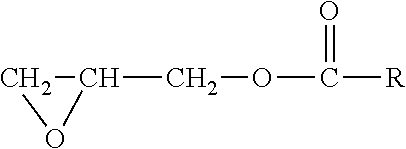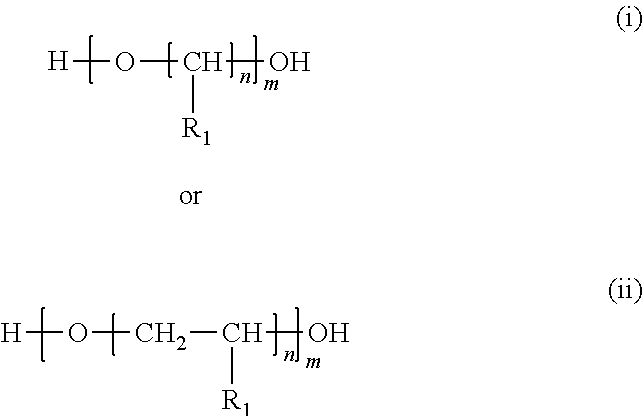Acrylic polymers, curable film-forming compositions prepared therefrom, and method of mitigating dirt build-up on a substrate
a technology of acrylic polymers and curable film, which is applied in the direction of coatings, polyurea/polyurethane coatings, etc., can solve the problems of affecting the surface of coated vehicles, other industrial substrates, and cohesive failure, and achieving incomplete removal of contaminant from the coated surfa
- Summary
- Abstract
- Description
- Claims
- Application Information
AI Technical Summary
Benefits of technology
Problems solved by technology
Method used
Image
Examples
examples
[0101]To evaluate the effectiveness of coating formulation changes on dirt adhesion, an ASPHALT ADHESION TEST was developed. Generally, the procedure is as follows: A 4″×12″ test panel is coated on both sides with the desired coating(s). After the appropriate cure time, one-quarter inch diameter plastic compression sleeves are placed on the test panel surface and filled with about 0.15 grams of Asphalt Thin Crack Filler, available from CP Industries of Salt Lake City, Utah. The asphalt in the compression sleeves is dried in a 150° F. oven for one hour. A minimum of 16 hours drying time at room temperature is allowed before attempting to remove the asphalt-filled sleeves from the test panel surface. The asphalt-filled sleeves are pulled off the clear surface by using an INSTRON MINI 44 machine and the associated software, made by Instron Corporation of Norwood, Mass. to obtain a quantitative value. A ring device attached to the arm of the Instron machine pulls the asphalt sleeve from...
example a
[0102]A dispersion of silica in DOWANOL PM (available from Dow Chemical Co.) was prepared via the following procedure. 564 g of NALCO 1340 from NALCO were charged into 5-liter reaction kettle equipped with a thermocouple, stirrer, reflux condenser and nitrogen inlet. The mixture was heated to 70° C., and held for 10 minutes. After that, a mixture of 1600 g DOWANOL PM and 20 g SILQUEST A174 (methacryloxypropyltrimethoxysilane) from Momentive was charged into flask over 1 hour, and held for 30 minutes at 70° C. The temperature was then increased to 110° C. to distill out 800 g solvent mixture. After that, a mixture of 100 g styrene, 20 g 4-hydroxybutyl acrylate and 20 g SILMER Mo8 from Siltech was charged over 1 hour, simultaneously with a mixture of 8 g LUPEROX 26 available from Luperox and 35 g DOWANOL PM. After completion of charge, the system was held at 110° C. for 30 minutes. A mixture of 2 g LUPEROX 26 and 35 g DOWANOL PM was charged into flask, and held for an additional 1 hou...
example b
[0103]A dispersion of silica in DOWANOL PM was prepared via the following procedure. 564 g of NALCO 1340 from NALCO were charged into 5-liter reaction kettle equipped with a thermocouple, stirrer, reflux condenser and nitrogen inlet. The mixture was heated to 70° C., and held for 10 minutes. After that, a mixture of 1600 g DOWANOL PM and 20 g SILQUEST A174 from Momentive was charged into flask over 1 hour, and held for 30 minutes at 70° C. The temperature was then increased to 110° C. to distill out 800 g solvent mixture. After that, a mixture of 50 g styrene, 20 g 4-hydroxybutyl acrylate, 50 g tridecafluorooctyl acrylate from Sumwise and 20 g SILMER Mo8 from Siltech was charged over 1 hour, simultaneously with a mixture of 8 g LUPEROX 26 and 35 g DOWANOL PM. After completion of charge, the system was held at 110° C. for 30 minutes. A mixture of 2 g LUPEROX 26 and 35 g DOWANOL PM was charged into flask, and held for an additional 1 hour. Finally, the temperature was increased to dis...
PUM
| Property | Measurement | Unit |
|---|---|---|
| Composition | aaaaa | aaaaa |
| Molecular weight | aaaaa | aaaaa |
| Aliphatic | aaaaa | aaaaa |
Abstract
Description
Claims
Application Information
 Login to View More
Login to View More - R&D
- Intellectual Property
- Life Sciences
- Materials
- Tech Scout
- Unparalleled Data Quality
- Higher Quality Content
- 60% Fewer Hallucinations
Browse by: Latest US Patents, China's latest patents, Technical Efficacy Thesaurus, Application Domain, Technology Topic, Popular Technical Reports.
© 2025 PatSnap. All rights reserved.Legal|Privacy policy|Modern Slavery Act Transparency Statement|Sitemap|About US| Contact US: help@patsnap.com


